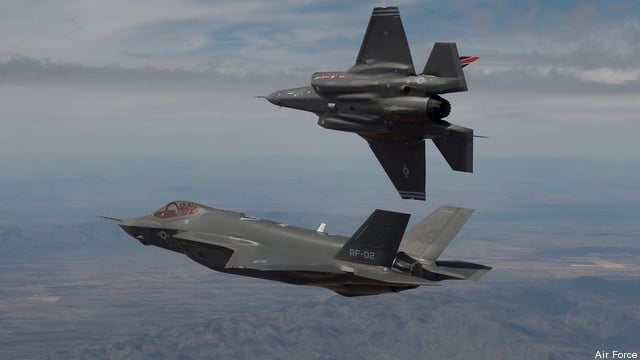New F-35 Wing Problem Surfaces: Exclusive
Posted on

UPDATED Washington: A new problem — described in a Pentagon email as “not a serious issue” — has been found with the wings of the Air Force and Marine versions of the F-35.
The problem is with the wing’s forward root rib and was discovered in standard durability tests. The ribs — which provide the core strength of the wings — must be redesigned. The problem appears to be one stemming from design — not quality control — and a redesign production plan for the affected F-35 fleet’s wings will be in place by the fourth quarter, a Capitol Hill source tells Breaking Defense.
“It’s good when you discover problems like this early and you can build in a better part in production,” the Hill aide said. The aide said the Pentagon had informed Congress about the problem.
The Joint Program Office, which runs the program, sent us a statement:
“…a shortfall in the predicted durability life of the Conventional Take Off and Landing (CTOL) and Short Take Off and Vertical Landing (STOVL) Wing Forward Root Rib was identified. The Root Rib is an aluminum part located where the Leading Edge of the Wing meets the Fuselage. The F-35 has a requirement to achieve 8000 flight hours verified through analysis and test to 2 lifetimes or 16,000 total hours. The CTOL durability test, being performed by BAE at Brough, UK recently completed more than 2,800 hours when the anticipated crack in the Forward Root Rib was identified.”
JSF spokesman Joe DellaVedova also said that “a redesigned full-life Forward Root Rib” has been designed for both aircraft. “In the interim, fleet and test aircraft continue to be inspected with a simple, non invasive inspection as a precaution ahead of eventual modification. The new Forward Root Rib design will be incorporated from the beginning of LRIP 5 for both CTOL and STOVL aircraft (AF31/BF35). [Some] 30 CTOL and 34 STOVL LRIP aircraft will require modification to achieve their full design life. The Forward Root Rib modification has been grouped with existing modification requirements to reduce both the cost of the modification and the time aircraft spend in deeper level maintenance. It is expected that the Forward Root Rib modification will require approximately 45 days to complete,” DellaVedova said in his email.
Lockheed Martin spokeswoman Laurie Quincy tells us that the fix “will not require additional funding for the F-35 program. The funding to be used is actually part of the concurrency costs that were already reported to Congress by the F-35 Joint Program Office earlier this year.” So the fix did cost new money but it’s old new money.
Yes, the SDD Test Jets-the CTOL and the STOVL versions will also require modification to achieve full design life.The difficult thing for the program will be the optic of the F-35B — on probation already and under fire by senior Navy officials — encountering a new problem. The good news is that this problem is shared with the Air Force version, considered by most the “simplest” version of the F-35 Joint Strike Fighter program. So no one –presumably — can point at the vertical take-off plane and say, here’s more proof the Marine plane is so complex that it should be shelved.
The JSF program recently came under heavy fire from Robert Work, Navy Undersecretary, who ordered Navy planners to present three alternative futures for naval aviation. The plans must embody “the best value alternative.” In his July 7 memo, Work told them to consider canceling the either the F-35B or the Navy carrier version, the F-35C. “This relook must consider every plan and program,” Work wrote.
The only real concern the congressional aide expressed was that the development and testing portion of the program is so much later than originally planned that so-called concurrency has become a bigger issue. Concurrency refers to the incredible juggling act that program and Lockheed Martin officials face in testing and building and modifying and testing the aircraft as they roll off the production line. Because of this and unanticipated problems with the aircraft, there are more production aircraft available at a lower state of development than there would have been under the earlier program schedule. And they will have to be modified.
Look for more vocal support for the F-35 on Capitol Hill as Congress returns to town next week. When Ash Carter, currently the head of Pentagon acquisition, goes before the Senate Armed Services Committee on Sept. 13 for his confirmation hearing to become Deputy Defense Secretary he is sure to face another round of questions about the F-35 from Sen. John McCain, who almost succeeded earlier this summer in passing legislation that could have led to the program’s death next year. But Sen. John Cornyn of Texas has threatened to press Carter at the upcoming hearing about “DoD’s failure to sufficiently defend and advocate” for the program.
Lockheed has clearly made the decision that the biggest program in American history is worth defending publicly.
Subscribe to our newsletter
Promotions, new products and sales. Directly to your inbox.
